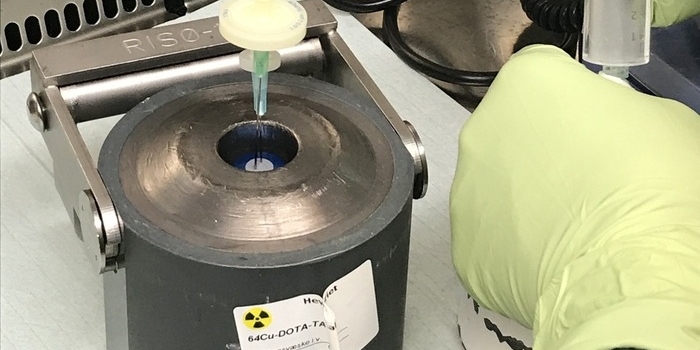Radioactive isotopes and tracers
The Hevesy Laboratory is specialised in the production of a wide number of radioactive isotopes for medical and technical purposes.

The GMP Unit ensures that the Hevesy Laboratory is a fully qualified/validated QC (Quality Control Laboratory) with a GMP (Good Manufacturing Practices) compliant organization.
The Hevesy Laboratory offer reactor produced radioactive isotopes for research and technical purposes.
These isotopes are produced by neutron irradiation of target materials at different reactors in Europe and the US. The irradiated materials are returned to DTU Health Tech, where they are processed, before the final products are distributed to customers in Denmark and abroad.
Bromine-82 is used by specialised companies in Denmark as a tracer for leak location in closed hot-water installations.
The isotope is produced by neutron irradiation of Ammonium bromide (NH4Br) and is distributed to costumers either as powder in small sealed water soluble PVA-plastic bags or as a water solution in 10 ml vials.
The isotope is delivered once a week depending on the availability of neutron irradiation capacity at different research reactors in Europe.
We produces 4 different types of sealed demonstration sources:
The sources are approved for educational use in schools in Denmark, Norway and Sweden.
Further specifications can be found in the “user manual” (in Danish).
The Hevesy Laboratory currently produces 18F-Fludeoxyglucose under a marketing permit and a number of other radiopharmaceuticals as part of a compassionate use programmes for diagnostic purposes.
The Hevesy Laboratory also produces and sells a number of isotopes which are not available from other sources. Enquiries concerning other isotopes are welcome. The laboratory possesses extensive expertise within production and handling of both reactor and cyclotron production.
On special request The Hevesy Laboratory offers on a commercial basis reactor produced radioactive isotopes in the form of unprocessed irradiations, sources and radiochemicals.
The Hevesy Laboratory applies neutron irradiations from reactors in Europe and the US for the research, health and industrial sectors.
Development of solid and liquid targets, for improved output in terms of activity, radiochemical speciation and specific activity.
At Hevesy lab we have a special commitment to the development of solid and liquid targets, for improved output in terms of activity, radiochemical speciation and specific activity. We have raised the available proton beam from our GE PETtrace cyclotron from the specified 80 microAmp to over 200 microAmp, giving 3.3 kW beam power to the target. We have now a solid target ( for radio-metals like Cu-64) capable of standing this power. We are still struggling to find a way to make F-18 with 200 microAmps. Of special interest in the development of targetry for istope productions are the development of diagnostic methods, both to monitor actual, in-beam production rates, but also for optimising beam quality. Beam quality can have a strong influence on the radiochemical availability of the radioisotope. This work is pursued as part of an international collaboration under IAEA.
One important goal is a reliable beam profile monitor, rapidly and remotely insertable and capable of withstanding full beam. Various “glowing mesh” approaches have been tested with some success, while the standard rotating helical wire scanner fails at or beam currents.
The routine production of Cu-64 is performed at the cyclotron and beamline facility at the Hevesy Laboratory. The isotope is produced in a (p,n) reaction by irradiating a solid enriched (99%) Ni-64 metal target with a 16 MeV proton beam. After the irradiation (duration 3 to 4 hours) the target is transferred to the laboratory for further processing. Chemical separation ensures that carrier-free Cu-64 is separated from the Ni-64 target material. A typical yield of Cu-64 after separation is 1.5 GBq.
An ongoing project is aiming at producing Cu-64 on a high-activity scale (5 – 10 GBq after chemical separation). For this purpose a so-called High Power Target that resists proton beam currents up to 200 µA has been developed. Such a high proton current reduces the irradiation time drastically and an activity of 10GBq of Cu-64 is easily reached within a few minutes of irradiation time.
These high activity levels of Cu-64 are difficult to handle safely in the laboratory without exposing the staff to a too high radiation dose. The present project therefore also includes the set up of an automation facility for the chemical separation process.